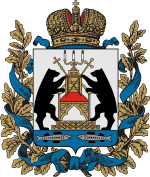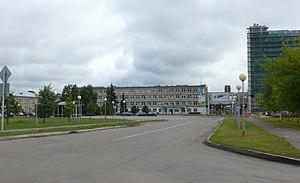User:LA2/Comparing two cities
Appearance
< User:LA2
| Linköping, Sweden | Veliky Novgorod, Russia |
|---|---|
 
|
 
|
Location[edit] | |
| Coordinates 58°24′39″N 15°37′18″E / 58.41083°N 15.62167°E | Coordinates 58°31′22″N 31°16′11″E / 58.52278°N 31.26972°E |
| (Almost exactly the same latitude, 16° difference in longitude. Both are well covered in OpenStreetMap and in Google Maps Street View.) | |
| On both sides of river Stångån (15 m³/s) near lake Roxen (95 km², 8 metres deep), navigable through Kinda Canal and Göta Canal. |
On both sides of Volkhov River (580 m³/s) near Lake Ilmen (982 km², 10 metres deep), navigable through Lake Ladoga and Neva River. |
| 200 km south-west of capital Stockholm along the country's main highway E4. |
190 km south-east of the megacity Saint Petersburg along the country's main highway M10. |
Dominating religion[edit] | |
 |
 |
| Linköping Cathedral (12th century) is centre of the Diocese of Linköping (Church of Sweden). Bishop is Martin Modéus. |
Cathedral of St. Sophia, Novgorod (11th century) is centre of the Diocese of Novgorod and Staraya Russa (Russian Orthodox Church). Metropolitan is Leo (Tserpitsky). |
Administrative division, population, area[edit] | |
 |
image missing |
| Linköping city has 104,232 inhabitants (2010) on 42 km² | Veliky Novgorod has 218,717 inhabitants (2010) on 90 km² |
| Linköping Municipality has 150,000 inhabitants (2013) on 1,568 km² | City + Novgorodsky District has 276,390 inhabitants (2010) on 4,690 km² |
| Note that the city is not a legal entity after the municipal reform in 1971. City hall politicians rule over the entire municipality (city + countryside). The title of mayor is used for the chairman of city hall (Ann-Cathrine Hjerdt, kommunfullmäktiges ordförande), not the head of the administration (Paul Lindvall, kommunstyrelsens ordförande). |
Novgorodsky District is a less important countryside district. City hall politicians rule over the city only. The title of mayor is used for the head of the administration (Yuri Bobrichev). |
 
|
 |
| Östergötland County has 429,852 inhabitants (2011) on 10,602 km². County governor is Elisabeth Nilsson. The governor is appointed by the national government and administrates various national agencies within the county, e.g. natural protection. In addition to this, an entirely independent and locally elected assembly, Östergötland County Council, administrates healthcare and public transport. The title Duchess of Östergötland was given to princess Estelle (born 2012), daughter of crown princess Victoria. |
Novgorod Oblast has 634,111 inhabitants (2010) on 55,300 km². Governor is Sergey Mitin. The governor is now appointed by the national government, but the assembly or duma is elected locally. |
History[edit] | |
| Rich medieval history. The country's second oldest cathedral. Older than Stockholm. Nearby are Alvastra Abbey, Vreta Abbey and old towns Vadstena, Skänninge. |
Rich medieval history. Birthplace of Russia as a nation. Older than Saint Petersburg. Nearby are several monasteries and the old town Staraya Russa. |
| Birger Jarl (1210–1266), born in Bjälbo, 40 km west of Linköping, consolidated the Swedish kingdom and founded Stockholm in 1252. Not formally a king himself, he extended Linköping Cathedral and used it for the coronation of his young son Valdemar in 1251. | Alexander Nevsky (1220–1263) was summoned in 1236 to be the prince of Novgorod, and in the Battle of the Neva in 1240 successfully defended it against Swedish and German invaders. In the Battle of the Ice on lake Peipus in 1242, he defeated the Livonian Order that had invaded Pskov. |
 |
 |
| Linköping Castle was the bishop's residence before the Lutheran reformation, hence the residence of the county governor. |
The Novgorod Kremlin is a brick fortress (1490) replacing an older wooden fortress, surrounding Sophia Cathedral and the regional museum and library. |
| Site of the Battle of Stångebro (1598) and the Linköping Bloodbath (1600). |
Site of the Massacre of Novgorod (1570) and occupied by Swedish forces (1611) during the Time of Troubles. |
| André Oscar Wallenberg (1816–1886) was born in Linköping, son of a bishop. In 1856 he founded a bank in Stockholm (now SEB), the first business venture of the Wallenberg family. | |
 |
 |
| Connected by railroad to Stockholm in 1872. Station building is from 1872. |
Connected by railroad to Saint Petersburg in 1871. Station building is from 1953. |
 |
 |
| Bronze statue and granite fountain Folkungabrunnen (1927) shows the region's history. | Bronze monument to the Millennium of Russia (1862) shows the country's history. |
 |
 |
| Theatre (1903) | Theatre (1987) |
 |
 |
| County history and art museum (1939) | Modern art museum |
 |
 |
| Former headquarter of Östgöta Enskilda Bank, founded in 1837, since 1997 a part of Danske Bank. | Main post office. |
| Not touched by World War I or II. | Occupied by Nazi Germany 1941–1944 and almost entirely destroyed. |
 |
 |
| The dominating industry is Saab Group, a maker of military aircraft, established in 1937, having 13,968 employees and a revenue of US$ 3.4 billion. Saab is controlled (30% owned) by Investor AB, a company of the Wallenberg family. |
The dominating industry is Acron Group, a maker of fertilizer, established in 1961, having 14,160 employees and a revenue of US$ 2.1 billion. Since privatization in 1993, Acron is owned by Viatcheslav Moshe Kantor. |
 |
 |
| Cogeneration plant, Tekniska Verken Kraftvärmeverket (1964), located near the train station. (A new 80 MW plant is being built, to be commissioned in 2016.) |
Cogeneration plant, Novgorodskaya TEC (1968), located on the Acron plant. Produces 360 MW electricity and heating. |
| Home to several military regiments (infantry, artillery, logistics, airforce) until the end of the Cold War. Home to the Swedish Air Force Museum. |
? |
| Has an airforce base west and a small commercial airport east of town. Skavsta at Nyköping and Arlanda at Stockholm are larger airports. |
The airport north of town is closed. Pulkovo Airport at Saint Petersburg is the closest. |
 |
 |
| Aircraft made by Saab are mounted (1987, 2004) along the motorway. | Victory Monument (1974), south of the Kremlin, to the victory over Nazi Germany in 1945. |
| Linköping University was created in 1975 by the merger of the institute of technology (1969), the humanities college, and teacher training college, dating back to a public school teacher seminar from the 1840s. It currently has 17,850 students and 1500 teachers. |
Yaroslav-the-Wise Novgorod State University was created in 1993 by the merger of the polytechnical institute (1973) and the pedagogical institute (1953), dating back to a seminar from 1740. It currently has 8,000 students and 900 teachers. |
| GRP per capita 309,000 SEK (2011, list) or Intl.$ 34,597 PPP (2013, estimated as 83% of national GDP). |
GRP per capita US$ 9,971 PPP (2009, list) or Intl.$ 16,397 PPP (2009, list). |
| Municipal tax revenue 36,000 SEK per capita (2011). Total municipal revenue 6.82 billion SEK (budget 2013) for 150,000 inhabitants. | City tax revenue 20,700 RUB per capita (2013). Total municipal revenue 4.55 billion RUB (outcome 2013) for 220,000 inhabitants. |
| The county has 3,641 farms (2013). Of the farms, 1,236 grow crops, 1,171 raise animals, 342 do both, and 892 are categorized as small farms. | The oblast used to have 2,900 farms (1994) but now has 700 (2014), of which only 400 are in active production. |
| Health care is administered by the Östergötland County Council ([1]). Linköping University Hospital is their biggest. | Health care is administered by the department of health of Novgorod oblast ([2]). Novgorod regional hospital (НОКБ) is their biggest. |
...to be continued...
